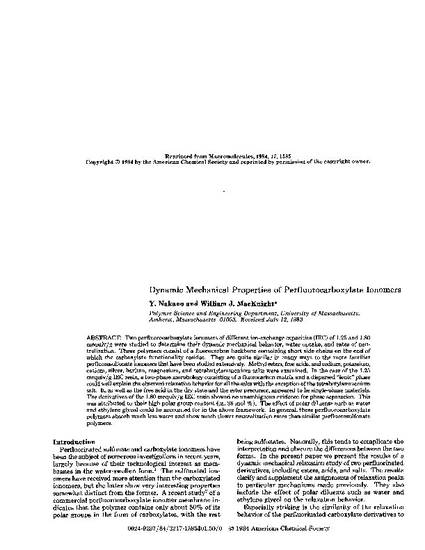
Article
Dynamic Mechanical Properties of Perfluorocarboxylate Ionomers
Macromolecules
(1984)
Abstract
Two perfluorocarboxylate ionomers of different ion-exchange capacities (IEC) of 1.25 and 1.80 mequiv /g were studied to determine their dynamic mechanical behavior, water uptake, and rates of neutralization. These polymers consist of a fluorocarbon backbone containing short side chains on the end of which the carboxylate functionality resides. They are quite similar in many ways to the more familiar perfluorosulfonate ionomers that have been studied extensively. Methyl esters, free acids, and sodium, potassium, cesium, silver, barium, magnesium, and tetrabutylammonium salts were examined. In the case of the 1.25 mequiv / g IEC resin, a two-phase morphology consisting of a fluorocarbon matrix and a dispersed "ionic" phase could well explain the observed relaxation behavior for all the salts with the exception of the tetrabutylammonium salt. It, as well as the free acid in the dry state and the ester precursor, appeared to be single-phase materials. The derivatives of the 1.80 mequiv / g IEC resin showed no unambiguous evidence for phase separation. This was attributed to their high polar group content (ca. 36 mol % ). The effect of polar diluents such as water and ethylene glycol could be accounted for in the above framework. In general, these perfluorocarboxylate polymers absorb much less water and show much slower neutralization rates than similar perfluorosulfonate polymers.
Keywords
- Dynamic Mechanical,
- Properties,
- Perfluorocarboxylate,
- Ionomers
Disciplines
Publication Date
1984
Citation Information
William MacKnight and Y. Nakano. "Dynamic Mechanical Properties of Perfluorocarboxylate Ionomers" Macromolecules Vol. 17 (1984) p. 1585 - 1591 Available at: http://works.bepress.com/william_macknight/114/
